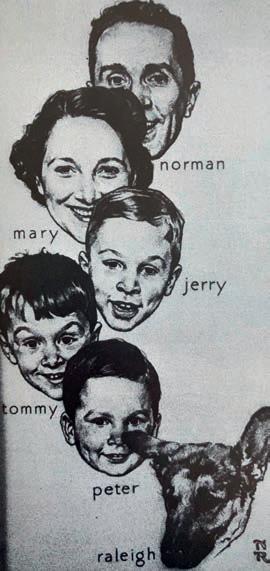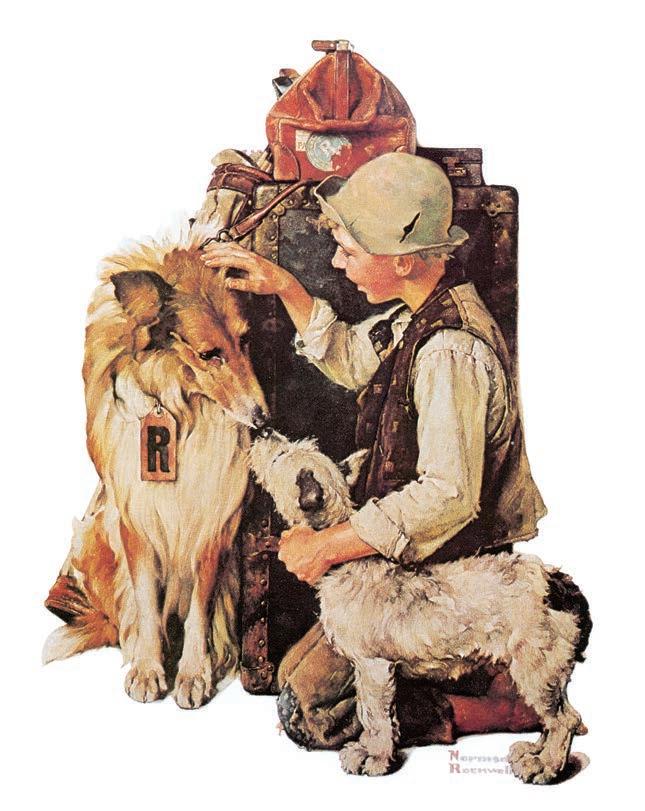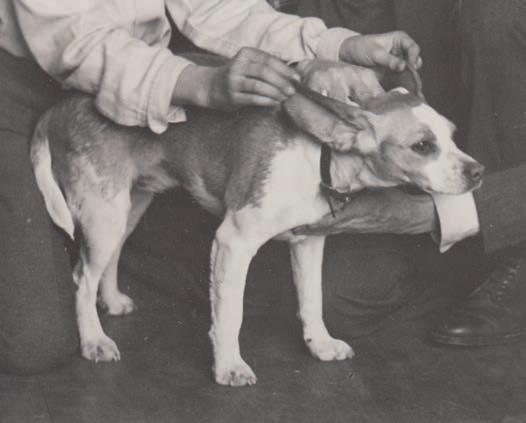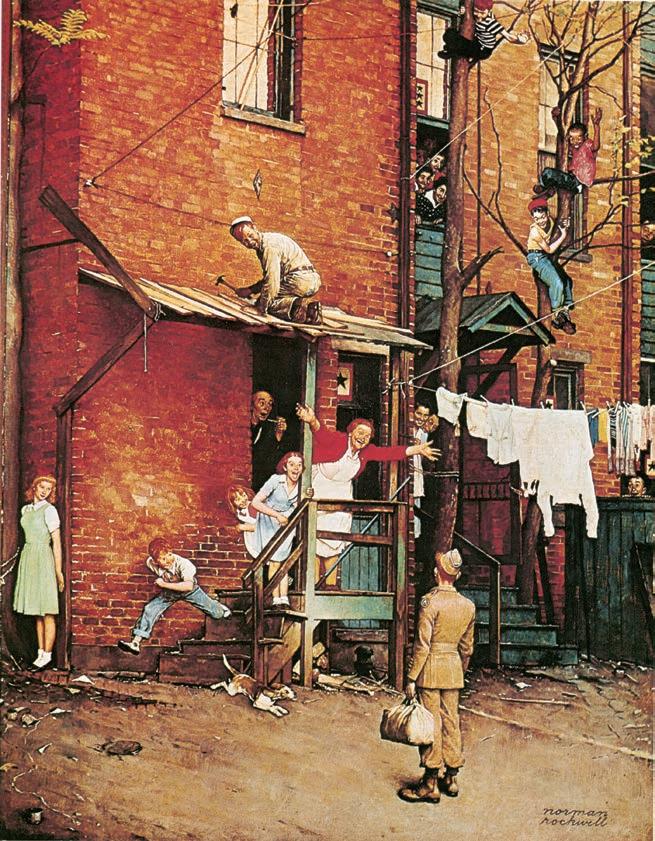
Boy with Dog in Picnic Basket, cover of the Saturday Evening Post (May 15, 1920). The boy is trying to keep his dog a secret as he rides the train, but the pup clearly wants to escape its hiding place.



Boy with Dog in Picnic Basket, cover of the Saturday Evening Post (May 15, 1920). The boy is trying to keep his dog a secret as he rides the train, but the pup clearly wants to escape its hiding place.

There were dogs in Norman Rockwell’s house and dogs in Norman Rockwell’s studio. He had dogs as pets and dogs as models. O en his pets became his models, appearing on his famous covers for the Saturday Evening Post and other magazines. Raleigh, Butch, and finally Pitter were all Rockwell family pets who appeared in his paintings and his drawings. He also used strays, his neighbors’ dogs, dogs from the pound, and even the famous Hollywood star Lassie as models. Rockwell knew the importance of man’s best friend in his life and in his work.
At the beginning of his career, Rockwell illustrated children’s magazines almost exclusively, and he needed boys and dogs to pose for his paintings. In his autobiography, My Adventures as an Illustrator, he
Cousin Reginald Goes to the Country, cover of Country Gentleman (August 25, 1917). Patsy rides in the front of the cart with her ears blowing in the wind as Cousin Reginald is introduced to country life.

Cousin Reginald Goes Fishing, cover of Country Gentleman (October 6, 1917). Cousin Reginald tries to fish and only catches Patsy the dog.



 Newlyweds Norman and Mary Rockwell pose with Raleigh the German shepherd outside their home on Lord Kitchener Road in New Rochelle.
Newlyweds Norman and Mary Rockwell pose with Raleigh the German shepherd outside their home on Lord Kitchener Road in New Rochelle.
The artist’s biographers write of the dogs he had as pets. He and his first wife Irene invited a German shepherd into their household in 1926. They named him Raleigh. This was when Rockwell’s fame was beginning to grow and fans were starting to seek him out in New Rochelle. Raleigh helped the artist feel more secure, accompanying him to and from the studio every day. The bond between the dog and his master was strong, and when Rockwell traveled to Europe in 1929 without his wife, or his dog, Raleigh became despondent. Perhaps Rockwell was reflecting on his regrets about leaving his pet behind when he painted a dog sitting patiently beside his owner’s luggage with an R around his neck—the R might have been for Raleigh, or maybe Rockwell—in a 1929 Post cover, Boy with Two Dogs. Norman and Irene divorced in January 1930, and he married Mary Barstow in California later that spring. In a photograph of the newlyweds in front of their home on Lord Kitchener Road in New Rochelle, Raleigh appears with them. Raleigh did eventually travel across the Atlantic in 1932, when Norman, Mary, and their six-month-old
son Jarvis moved to Paris for eight months. When they returned to New Rochelle, Raleigh made it into family photographs. He looks very comfortable posing for a snapshot with Rockwell’s two young sons, Jarvis and Tom. Raleigh would be the model for a Saturday Evening Post cover published in November 1935, entitled Man Hiking with Dog. He would also
Rockwell drew this portrait of his whole family, including Raleigh, in Arlington, Vermont, c. 1940. It was used on a Christmas card sent to friends and family.

Boy with Two Dogs, cover of the Saturday Evening Post (September 28, 1929). The “R” around the collie’s neck may refer to Rockwell’s own dog, Raleigh, whom he had le behind when he traveled to Europe.

In October 1948, a little over a year a er Going and Coming was featured on the cover of the Post, Butch disappeared from Rockwell’s Arlington home. Dogs in the Vermont countryside were allowed to roam free, but it wasn’t like Butch to stay away for too long. Rockwell walked several miles along the Batten Kill River calling for the dog. The police ended up rescuing the poor creature from a fox trap that had snared him in the woods. Rockwell was greatly relieved that Butch was not seriously injured. When a reporter from the Bennington Banner called Rockwell to ask how the dog was, the artist was happy to report that Butch was curled up at home with “a contented look” on his face, despite his injured paw.


The dogs in Rockwell’s paintings were always part of the story the artist wanted to tell. “I do not like to see an appealing animal put into a picture just to save the job,” explains the artist. “This trick does not fool anyone. I never include an animal in any picture unless it seems natural for it to be in the setting. But when you have a scene in which animals might be expected to appear, paint them well and put them in because people love to see them.”
People certainly appreciated Rockwell’s paintings of animals. He would o en receive letters praising a dog he had painted and not necessarily making any comment on the humans in the same work.
Rockwell frequently used a dog to help express the emotion he was trying to convey in a painting, as in his depictions of soldiers coming home at the end of the Second World War. The exuberant welcome a family and the entire neighborhood extend to a returning veteran is reflected in a dog’s ears, which fly back in enthusiasm as the pet rushes toward its long-missed companion. And when the serviceman is truly home and able to doze in his backyard hammock, with his dog happily snuggled on top of him, this time the ears are relaxed and at peace.
The Homecoming, cover of the Saturday Evening Post (May 26, 1945). The whole neighborhood, including the family dog, extends a warm welcome to a returning World War II veteran in this Post cover, which hit newsstands just eighteen days a er Germany surrendered. In the reference photo, the dog posing with ears held back is Spot, who belonged to Ardis Edgerton, Rockwell’s neighbor in West Arlington, Vermont. Edgerton also modeled for this painting; she is the little girl with the red hair and blue dress on the staircase.



A er his wife Mary died in 1959, Rockwell was alone in his Stockbridge home. His daughter-in-law Gail, Tom’s wife, found Pitter, a beagle mix, in Pittsfield’s rescue shelter. She thought her father-in-law needed a dog and Pitter needed an owner, so she brought the dog to Stockbridge. Named a er his hometown, Pitter provided companionship to the widower and modeled for his paintings and drawings.
Rockwell at work in his Stockbridge studio, with Pitter relaxing nearby.
Rockwell leaving his studio on South Street, Stockbridge, with Pitter the beagle mix.

70
In 1961, Rockwell married Molly Punderson. The year a er their wedding, Pitter would be featured on Molly and Norman Rockwell’s Christmas card, which shows them out for a walk, Pitter’s ear and Molly’s scarf blowing in the wind as they all stride forward. Rockwell used Pitter as a model for Juvenile Cowboy in 1960 and for the Boy Scout calendar painting in 1964. He would also use a reference photo of his old dog when composing Home from Camp in 1968, long a er Pitter’s death in 1964.
Detail of Juvenile Cowboy, 1960. Rockwell included this very fine drawing of Pitter in an advertisement for the Massachusetts Mutual Life Insurance Company.

Rockwell drew his wife Molly, his dog Pitter, and himself for a Christmas card the couple sent out to friends and family in 1962.

of a series examining country life, the dog waits quietly on the rocking chair next to the fire while the doctor talks with the family about the child’s health. The canine model was a spaniel named Bozo who lived in Arlington, Vermont, with his owner, Dr. Russell.
 Norman Rockwell Visits a Family Doctor, illustration for the Saturday Evening Post (April 12, 1947). In this painting, part
Norman Rockwell Visits a Family Doctor, illustration for the Saturday Evening Post (April 12, 1947). In this painting, part


